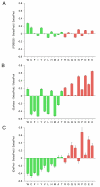Composition Profiler: a tool for discovery and visualization of amino acid composition differences
- PMID: 17578581
- PMCID: PMC1914087
- DOI: 10.1186/1471-2105-8-211
Composition Profiler: a tool for discovery and visualization of amino acid composition differences
Abstract
Background: Composition Profiler is a web-based tool for semi-automatic discovery of enrichment or depletion of amino acids, either individually or grouped by their physico-chemical or structural properties.
Results: The program takes two samples of amino acids as input: a query sample and a reference sample. The latter provides a suitable background amino acid distribution, and should be chosen according to the nature of the query sample, for example, a standard protein database (e.g. SwissProt, PDB), a representative sample of proteins from the organism under study, or a group of proteins with a contrasting functional annotation. The results of the analysis of amino acid composition differences are summarized in textual and graphical form.
Conclusion: As an exploratory data mining tool, our software can be used to guide feature selection for protein function or structure predictors. For classes of proteins with significant differences in frequencies of amino acids having particular physico-chemical (e.g. hydrophobicity or charge) or structural (e.g. alpha helix propensity) properties, Composition Profiler can be used as a rough, light-weight visual classifier.
Figures


References
-
- Molecular Surface Package http://www.biohedron.com
Publication types
MeSH terms
Substances
LinkOut - more resources
Full Text Sources
Other Literature Sources
Molecular Biology Databases
Research Materials

